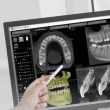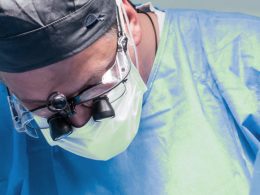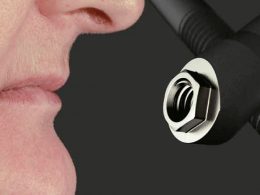Table of Contents
Bone atrophy is a natural phenomenon that occurs after tooth extraction, which worsens over time due to the use of removable dentures and other pathologies.
Patients with severe maxillary atrophy, due to many years of removable dentures use, sometimes do not have the minimum volume or quality of bone necessary to opt for conventional dental implants.
The situation can be similar when teeth are still present, but they are affected by serious infections or periodontal diseases that cause the destruction of the alveolar bone. Often, these patients are discarded for conventional treatment with dental implants.
In the past, huge and heroic maxillary reconstructions were made with bone grafts from the patient himself, extracted from other areas of his body (mainly the head and pelvis), in some cases achieving to place dental implants and providing him with a fixed prosthesis. However, the procedure was bloody (with many bodily injuries and hours in the operating room), slow, expensive, and with high probabilities of failure.
Why Are Bone Grafts Not So Good?
Bone grafts are excellent for treating periodontal disease or correcting localized defects prior to conventional implant placement, but not for reconstructing a complete maxilla.
If the resorption is severe, the graft will have to be bulky, therefore it must be extraoral (cranial bone grafts, iliac crest of the hip, chin block or mandibular branch grafts) and there will be a post-operative with important morbidity and complications. The post-operative times of these techniques are quite extensive, not less than 6 months, and are usually performed in more than one surgical act. In addition, they are very expensive and with a possibility of failure of up to 60%.
What Does Modern Dentistry Offer?
The possibility of a fixed complete oral rehabilitation for patients with little bone in their jaws, almost immediately, in only 1 surgical approach and without the need for multiple and extensive reconstructive surgeries.
Zygomatic implants, also known as “implants for patients with little bone”, are longer than conventional dental implants, and unlike these, they are anchored to the inside of the cheekbones, so they do not depend on the conditions of the maxillary bone.
This method is used for severely resorbed upper jaws and is designed to facilitate immediate rehabilitation with fixed dentures.
Zygomatic implants are inserted intraorally, at the level of the posterior section of the maxilla, sometimes with one or more additional conventional implants in the premaxilla, and in the most severe cases, two zygomatic implants on each side, which is then called like Quad Zygoma.
The Quad Zygoma Concept
Zygomatic implants offer another alternative to the Surgeon when planning an implant-supported rehabilitation, especially in those patients with an extremely atrophic maxilla in which the bone grafts are not viable or have failed.
With 4 zygomatic implants, even seemingly-impossible situations, can be solved with fixed teeth.
The technique is based on the concept of quadruple support to achieve balance, stability and the correct distribution of chewing loads. As is done when manufacturing a table or chair, the Surgeon will seek to place the 4 implants as symmetrical and equidistant as possible, to counteract the lever arms and guarantee the longevity of the rehabilitation.
What Are the Steps of the Procedure?
Prior to the surgical procedure, we do a thorough and extensive examination to accurately assess the situation. We will first make photos, stone plaster models of your teeth and a three-dimensional tomography (CBCT). This is necessary to accurately determine the location and length of the implants.
These preoperative dental studies are completely painless for the patient and only take a few minutes. Surgery is then performed under general anesthesia, since the placement of zygomatic implants is more complex and invasive than conventional implants. Anesthesia is always performed by an Anesthesiologist in a surgical block in a hospital environment. Broadly speaking, the surgical approach includes the following steps:
- Incisions In the maxillary alveolar crest, extending from the first molar right region to the left one, paying attention not to injure the emergence of the descending palatine artery that, due to anatomical evolution of the atrophic maxilla, may arise in the alveolar crest. In addition, two posterior vestibular incisions are made bilaterally, and a median releasing incision is made below the nasal spine.
- Mucoperiosteal Flap A mucoperiosteal flap is raised simultaneously bilaterally along the whole incision or in two separate stages. In case of Quad Zygoma surgery, the bone region exposed after the mucoperiosteal flap reflection is wider, and it reaches the lower orbital rim. The infraorbital foramen is localized and isolated both medially and distally, what for the emergence of the infraorbital nerve is meticulously ensured and protected during the entire surgical phases, since the anterior zygomatic implant must be placed at a safe distance from that nerve.
- Implant Site Preparation Corticotomies (cuts into the zygomatic bone) are performed with a sequence of drills and burs mounted on a contra-angled handpiece. This instrument allows adequate posterior positioning of the zygomatic implant, distal to the region of the upper second premolar. The emergence of the anterior implant should be at the level of the canine region, at the lowest point of the alveolar crest.
- Implant Positioning The implant is positioned with an extraoral screwdriver if the anatomy is favorable, or with the usual operations of screwing that we use in all types of endosseous implants. The emergence of the fixture must be in the optimal site from a prosthetic point of view, on the alveolar crest. The angled abutment position is checked in order to obtain an ideal emergence of the prosthetic abutment, and it is screwed.
- Wound Cleaning and Suturing The resorbable suture completes the surgical intervention.
The duration of the intervention is usually between one and two hours, logically depending on the complexity of the case.
After the zygomatic implants have been placed, the implant positioning is transferred onto a stone plaster model with an impression. Our dental technicians then construct a temporal bridge, which can be screwed onto the new implants in a few days, unless there is a contraindication for it. Due to the high strength of the bony tissue of the zygomatic bone, implants and prostheses can generally be used immediately after surgery.
Is It Always Necessary to Place 4 Zygomatic Implants?
Not always!
Quad Zygoma technique is only necessary in the most severe cases, when bone resorption also affects the anterior portion of the maxilla.
In our clinic, people with inadequate bone volume for the placement of conventional implants are treated using one of the following three techniques, all without grafts:
1- The All-on-4 implant technique.
2- Technique combined with four conventional implants in the front and two zygomatic or pterygoid implants in the back.
3- Two zygomatic implants on each side (Quad Zygoma).
Are There Any Contraindications for Quad Zygoma Technique?
Contraindications to the use of zygomatic implants include acute sinusitis, maxillary or malar pathology, and patients who cannot undergo implant surgery because of underlying uncontrolled systemic or malignant disease. Relative contraindications include chronic infectious sinusitis, the use of bisphosphonates in women, and smoking more than 20 cigarettes a day.
Any pathology of the maxillary sinus should preferably be treated before the placement of the zygomatic implants.
“Without Any Discussion, Zygomatic Implants Are the Only and Great Alternative that Patients With Little Bone in Their Upper Jaws Have to Achieve Fixed Rehabilitations”.
DENTAL TIP
Save Up to 70% on Your Maxillofacial Surgery!
Never forget that dental tourism is an extraordinary tool for accessing top-notch Dentistry.
DENTAL VIP trusts that quality of dental care should be affordable to all, no matter where you live. Hundreds of patients come to Venezuela for state-of-the-art medical and dental care every year, saving large amounts of money on health. Our rates are significantly lower than in any other Latin American country, without it implying a decrease or compromise in the quality of service. Our Maxillofacial Surgery Team is one of the best in the country and has extensive experience in zygomatic implants, orthognathic surgery and the surgical treatment of maxillary pathology.
We guarantee that by using the services offered by DENTAL VIP, you will be cared for in modern operating rooms, with state-of-the-art equipment and under the standards of the most demanding international surgical protocols.
Come for the price and stay for the quality! Contact us today through WhatsApp +58 414-9033547 or Email and we will let you know, according to your case, all the evaluations and preoperative studies required for this type of interventions.












